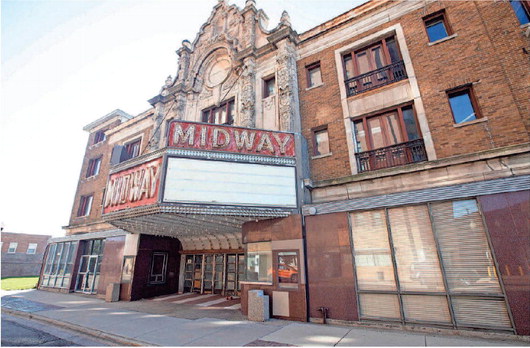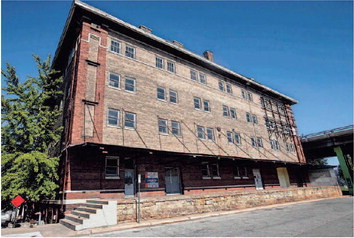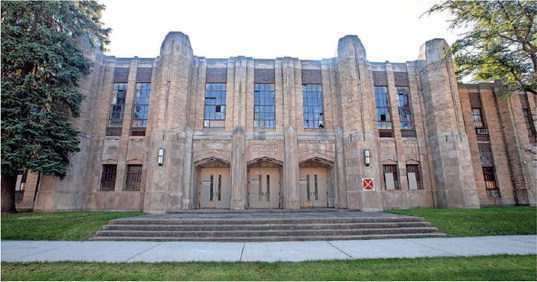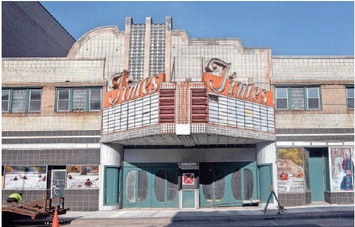

Jeff Kolkey
Rockford Register Star USA TODAY NETWORK
ROCKFORD
Downtown Rockford is home to plenty of once proud historic buildings which over the years were written off as unsalvageable only for them to be revived with large investments of money, effort and patience. The dilapidated former Amerock factory was headed for the wrecking ball before it was transformed by Wisconsin- based Gorman & Co. into the 160room Embassy Suites by Hilton Rockford Riverfront. Built in the 1930s, the 114,682-square-foot Talcott Building, 321 W. State St., was a tired office building until Urban Equity Properties turned it into the Residences at Talcott, now a mixed use building of apartments, offices and commercial space. The ornate but aged Coronado built in 1927 was revived as the Coronado Performing Arts Center in 2001 thanks to an $18.5 million fundraising campaign.
But for every success story, another of Rockford’s historic downtown
buildings remains vacant and in some cases growing more deteriorated and damaged every year, historic preservationist and architect Gary Anderson of Studio GWA said. “We have made great strides in redeveloping some significant buildings in downtown Rockford,” Anderson said. “However, we have many more landmark structures that are worthy of preserving and revitalizing. These structures have faced some very hard times, but they can be great contributors to our community if given the
opportunity with an owner that has the capability to renovate the structure.”
Here are our top picks for the five historic downtown Rockford buildings that ought to be saved and redeveloped.
Midway Theater
Address: 721 E. State St.
History: The Midway Theater opened Aug. 3, 1918, and was a movie house for much of its history. It was designed in the Spanish Renaissance style by the renowned architect J.E.O. Pridmore. It was built with space for 21 apartments, four retail stores and a basement bowling alley, according to historic preservation documents. And it was air conditioned — cool, water-filtered air was supplied to the theater, “thus assuring patrons of clean, pure and cool air,” according to a historic landmark
application. Arts lovers in 1996 — after a study and market analysis — ultimately chose to back the renovation of the Coronado over the vacant, 2,000-seat Midway Theater. Designating the Midway a historic landmark saved the structure from demolition after it was badly damaged by a 1980 fire that broke out in a tavern called the Cypress Lounge, housed at the Midway. By 1983 it had been renovated into a concert hall and served as the home of the Rockford Symphony Orchestra until 2000. It has been rarely used since then.
The latest: Peter S. Crane bought the building that serves as an unofficial marker for entering downtown along East State Street in 2010 for $90,000. Crane had plans for a renovation that never materialized. When one of the trusses that form the skeleton of the roof in the rear of the building gave way in March 2012, a portion of the roof collapsed. It was repaired, but no further work proceeded. Rockford fined the owner for code violations in 2018 and took the owner to court in an effort to force him to bring it into compliance or prod him to move forward with renovations. That case is continuing. The roof was again damaged during a windstorm earlier this
year.
Revers Marina
Address: 222 N. Water St. History: A five-story riverfront marina built around 1890, the Revers Marina was originally a grocery warehouse that was served by rail for decades. It has a heavy timber wood construction and masonry exterior. The Revers family utilized the 48,600-square-foot building as a marina, boat storage and boat repair shop for about 60
History: A five-story riverfront marina built around 1890, the Revers Marina was originally a grocery warehouse that was served by rail for decades. It has a heavy timber wood construction and masonry exterior. The Revers family utilized the 48,600-square-foot building as a marina, boat storage and boat repair shop for about 60
years.
The latest: After a redevelopment deal fell through, the property was featured on the “American Pickers” TV show on the History channel. Owner Jim Rever sold the American Pickers dealers antiques collected over the years at the business started in 1941 at a different Rockford location. It was condemned by the city for building
code violations in 2019 and placed up for sale for $1.5 million. When it didn’t sell, the asking price was reduced to $900,000. Rockford has filed a petition in circuit court asking a judge to enforce its $100,000 fine in an effort to encourage the owner to redevelopment the property, sell it to someone with a redevelopment plan or relinquish control to the city.
Elks Lodge
Address: 210 W. Jefferson St. History: The Elks Lodge was built as a social hall for the club in 1912 by Chicago architect Lawrence Buck. It was designed in the classical revival style with prairie style influences. There is a second floor, a classical revival ballroom with arched ceiling beams and a bowling alley on the lower level. The building was placed on the National Register of Historic Places in 2005. The Elks Club had sold the building in 1990 because of declining membership. The structure passed through the hands of several owners since then including Goodwill Industries which made some repairs and sold it to the current owner about a decade
was built as a social hall for the club in 1912 by Chicago architect Lawrence Buck. It was designed in the classical revival style with prairie style influences. There is a second floor, a classical revival ballroom with arched ceiling beams and a bowling alley on the lower level. The building was placed on the National Register of Historic Places in 2005. The Elks Club had sold the building in 1990 because of declining membership. The structure passed through the hands of several owners since then including Goodwill Industries which made some repairs and sold it to the current owner about a decade
ago.
The latest: The Elks Lodge has landed on Landmarks Illinois’ 2022 “Most Historic Endangered Places” in the state. A court has ordered the building owner to repair or demolish the building. Although there has been talk of redeveloping it as a restaurant and banquet venue, those plans have never materialized. And it has accumulated
tens of thousands in city code violation fines. Lawyers for Rockford have filed a petition in court to have the owner held in contempt for failing to following the court’s orders by a January deadline. A hearing was held over the summer, but no decision was made. Meanwhile, although the judge ordered the owner to take interim measures to secure the property and make it safe, city officials say that hasn’t happened. It heads back to court soon.
Armory
Address: 605 N. Main St.
History: The Art Deco former Illinois National Guard Armory was designed by local architects Bradley and Bradley opened in 1937. It was used until 1993, when the guard moved to the Machesney Park armory on North Second Street. It served as a vocational center for a time, but became mired in controversy, closed and the building fell into disrepair. As it deteriorated, the building was added to the National Register of Historic Places in 2000 and was donated to the City of Rockford in 2003.
The latest: The roof drainage system has failed and has deteriorated the wood roof deck, destroying its tongue and groove maple flooring. Although there is hope that the right developer will come along to breathe new life into the property, that hasn’t happened so far. Over the years, there have been plans to turn it into an aquarium and even a group that tried to attract George Lucas’ Museum of Narrative Art that’s being built in Los Angeles. Fingers crossed this historic building will find the right, well heeled developer who knows how to harness historic tax credits and navigate the complex capital stack redevelopment would require.
Times Theater
Address: 224 N. Main St.
History: One of two Rockford movie houses designed in the Art Moderne style, the Times Theater opened in 1938 with a showing of “Thoroughbreds Don’t Cry,” starring Mickey Rooney and Judy Garland. The theater boasted about it’s temperature controlled atmosphere as well as its 1,000-seats that were moth and fireproof. The theater ceased operation as a movie theater in the early ‘80s. Although revived for a short period as a cabaret and then a night club, it has been decades since the theater was used to screen movies and it has been closed for 20 years.
designed in the Art Moderne style, the Times Theater opened in 1938 with a showing of “Thoroughbreds Don’t Cry,” starring Mickey Rooney and Judy Garland. The theater boasted about it’s temperature controlled atmosphere as well as its 1,000-seats that were moth and fireproof. The theater ceased operation as a movie theater in the early ‘80s. Although revived for a short period as a cabaret and then a night club, it has been decades since the theater was used to screen movies and it has been closed for 20 years.
The latest: Acquired by SupplyCore CEO Peter Provenzano’s Joseph James Partners, the Times could get another lease on life. Provenzano hopes to renovate the theater into a multi-use facility and entertainment venue capable of seating 650 to 900 people for concerts, plays, comedy shows and occasional films. Plans are to restore the Art Moderne architecture of the auditorium and lobby while adding a new balcony that could seat 150. There would be space for a restaurant with take-out food and a lounge with an auxiliary stage. Joseph James has acquired a $3 million state grant to help pay for a portion of what is envisioned as a $14 million project.
Waterpower District Foundation © 2021. All Rights Reserved